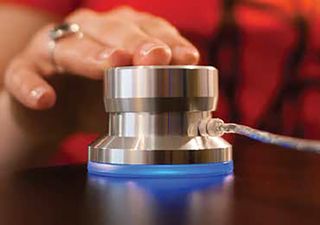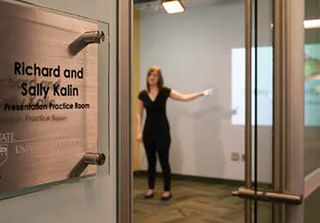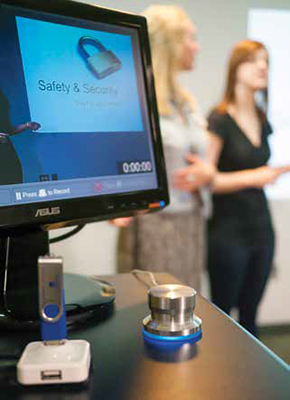This Penn State studio offers one-button control and H.264 encoding. As Penn State students begin their Fall semester, many will be joining their peers in classes with a significant presentation requirement. These are not just classes within the College of Communications, which hosts the most common public speaking courses at the University. Faculty in Business, Liberal Arts, Engineering, and other disciplines increasingly recognize that effective oral presentation skills provide benefits throughout a student’s career, starting at their first job interview.
While the prospect of delivering presentations in front of an audience causes extreme anxiety in many young people, faculty also face several practical barriers to incorporating presentation assignments in their courses. First, in a typical class of 25-35 students, let alone a not-at-all-uncommon 300+ student course, it’s difficult to set aside classroom time for each student to deliver a 5-10 minute presentation. Second, it is often desirable to create and share a recording of these presentations, which provides an opportunity for faculty and classmates to review and offer more thoughtful feedback. Creating a quality recording where slide text and spoken audio is clearly discernable can be expensive, time-consuming, and sometimes require a trained videographer to be present in class. These challenges often cause faculty to forgo a presentation activity.
In my role as Assistant Director of Education Technology Services (ETS), a teaching and learning-focused group within central IT at Penn State, I am responsible for evaluating and developing new technologies for the University. I also oversee the Media Commons, a service dedicated to helping students and faculty integrate digital media into their coursework. It was the Media Commons staff, who consult with about 7,000 students each semester, that helped identify the need to make presentation practice easier and more approachable for faculty and students.
The One Button Studio was the result of an obsession on our part to create the most streamlined studio experience possible. Our overarching requirement was that the entire studio workflow must be controlled by a single button. The button we chose is a programmable USB device that sends simple keyboard commands to a computer. Custom software written by my team receives those commands and activates LED studio lighting and begins receiving video signal from a standard consumer HD camera run through H.264 encoding hardware. The encoder allows us to display a live feed that aids students in composing their shot and also creates a video stream the computer can store. Another press of the button starts a countdown to begin recording. A final click stops the recording and copies the video file to a USB flash drive provided by the student (a full equipment list can be found at http://onebutton.psu.edu/setup/).


With a streamlined operator process, Penn State students can quickly rotate through the studio, even on the busiest school day.
The One Button Studio makes this process quite intuitive, and plenty of error checking ensures it is robust, minimizing lost presentations. Therefore, a majority of her time is spent presenting, not wrestling with technology, and the studio is already ready for the next student to use. With almost no overhead in the process, an endless procession of students can quickly rotate through a studio throughout a busy day. In fact, in the 2013-2014 academic year, 4,295 students, faculty, and staff used the two One Button Studios at our University Park campus. They created 7,973 videos comprising 345 hours of video. All of this was accomplished with minimal training or technology maintenance.
Many of the institutions that have installed a studio have similarly reported rapid adoption and a significant improvement in the way they support faculty and students through the digital media creation process. Most importantly, they are providing young people who have butterflies in their stomachs with an opportunity to take one step toward becoming great orators.
Chris Millet, M.Ed., is the Assistant Director of Education Technology Services (ETS) at The Pennsylvania State University. Editor’s Note—This editorial reflects the opinions of Chris Millet and does not represent the official position of The Pennsylvania State University.
Key Elements / / for the End-User
ROI:
In the 2013-2014 academic year, 4,295 students, faculty, and staff used the two One Button Studios at our University Park campus. They created 7,973 videos comprising 345 hours of video. All of this was accomplished with minimal training or technology maintenance.
NEXT LEVEL:
Interested institutions can create a One Button Studio for use as a presentation practice space for around $7,000, or much less if existing equipment can be repurposed. The free software and an installation guide can be found on http://onebutton.psu.edu.










